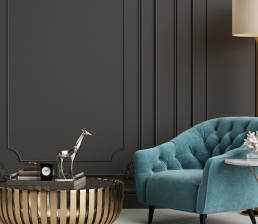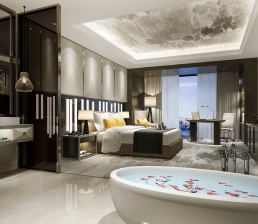Types of False Ceiling and Its Benefits
Types of False Ceiling and Its Benefits
False ceilings, also known as suspended or dropped ceilings, are secondary ceilings that are suspended below the primary ceiling. They are a popular design choice for homes, offices, and commercial spaces due to their aesthetic appeal and functionality. False ceilings offer a range of benefits, including improved acoustics, lighting, and energy efficiency. There are various types of false ceilings, each with its unique features and applications. In this article, we will discuss the most common types of false ceilings and their benefits.
Gypsum Board False Ceiling

Gypsum board, also known as drywall or plasterboard, is a popular material used in false ceiling systems. It is lightweight, easy to install, and can be painted or textured to match any interior design. Gypsum board false ceilings are commonly used in residential and commercial buildings due to their durability and affordability. They are also fire-resistant and offer good insulation against sound and heat.
There are several uses for artificial ceilings made of gypsum board, such as:
Residential buildings: To enhance a space’s acoustics, lighting, and energy efficiency, false ceilings made of gypsum board are frequently utilized in residential buildings. They can also be utilized to give an appearance that is more streamlined and to hide services. In a modern luxury master bedroom, consider the elegance of gypsum false ceilings to add a touch of sophistication and versatility, creating an ambience of refined comfort while accommodating various lighting options for a truly luxurious and personalized retreat.
Commercial buildings: Offices, retail establishments, and dining establishments frequently employ fake ceilings made of gypsum board. They can be utilized to hide services and enhance a space’s acoustics, as well as to assist in creating a more polished and welcoming feel. In contrast, luxurious hotel interior design often employs intricate detailing, abundant materials, and carefully curated elements to create a sophisticated ambience that delights guests and elevates their overall experience.
Industrial buildings: To hide utilities, enhance acoustics, and save energy expenses, gypsum board false ceilings are also utilized in these types of buildings.
Metal False Ceiling

Metal false ceilings are made from metallic materials such as aluminium, steel, or copper. They are highly durable and can withstand extreme temperatures and humidity levels. Metal false ceilings are commonly used in industrial and commercial buildings such as airports, factories, and hospitals. They are also suitable for areas that require high hygiene standards, such as food processing plants and laboratories.
Applications for metal false ceilings are numerous and include the following:
Industrial structures: To hide utilities, enhance acoustics, and lower energy costs, metal fake ceilings are frequently utilized in industrial structures.
Commercial buildings: Offices, retail establishments, and dining establishments frequently employ metal false ceilings. They can be utilized to hide services and enhance a space’s acoustics, as well as to assist in creating a more polished and welcoming feel.
Healthcare facilities: Because of their sturdiness, hygienic qualities, and fire resistance, metal fake ceilings are frequently utilized in healthcare facilities, including hospitals and clinics.
Food processing plants: Because of their longevity and hygienic qualities, metal fake ceilings are also a popular option for these facilities.
Wooden/WPC False Ceiling

Wooden false ceilings are made from natural or engineered wood materials such as timber, plywood, or MDF. They offer a warm and natural look and are suitable for traditional or contemporary interior designs. Wood false ceilings are commonly used in residential and commercial spaces such as restaurants, hotels, and boutiques. They also offer good acoustic insulation and can be stained or painted to match any colour scheme.
For instance Moroccan restaurant design, the warm and natural aesthetic of false wooden ceilings can be artfully integrated to evoke a sense of authenticity and enhance the overall ambience, creating a captivating fusion of cultural influences.
Wood false ceilings, crafted from natural or engineered materials like timber, plywood, or MDF, provide a warm and natural aesthetic and seamlessly complement traditional and contemporary interior designs. Their versatility extends to various settings, finding frequent applications in residential spaces and commercial establishments such as restaurants, hotels, and boutiques.
Beyond their aesthetic appeal, wood false ceilings offer excellent acoustic insulation, enhancing the overall comfort of the space. Furthermore, their adaptability allows for staining or painting, ensuring they effortlessly integrate with any chosen colour scheme. This makes them a favoured choice for those seeking a timeless, customizable design solution.
WPC/PVC False Ceiling
PVC false ceilings are made from polyvinyl chloride (PVC)/ wood plastic composite (WPC) materials and offer a range of benefits, such as durability, water resistance, and low maintenance. They are lightweight and easy to install and can be shaped and designed to match any interior design. PVC false ceilings are commonly used in commercial and industrial buildings such as hospitals, schools, and warehouses.
The versatility of WPC false ceilings extends beyond their durability and water resistance; these lightweight, easy-to-install ceilings are highly adaptable, allowing them to be shaped and designed to integrate seamlessly into any interior design. Their low-maintenance quality adds to their appeal, making them a practical choice for various settings.
Particularly prevalent in commercial and industrial buildings, including hospitals, schools, and warehouses, PVC false ceilings combine functionality with aesthetic adaptability, providing a cost-effective and efficient solution for spaces with paramount durability and design flexibility.









April 14, 2025
Alfredo3933
https://cr-v.su/forums/index.php?autocom=gallery&req=si&img=4019
April 21, 2025
Eliza3962
Very good https://is.gd/tpjNyL